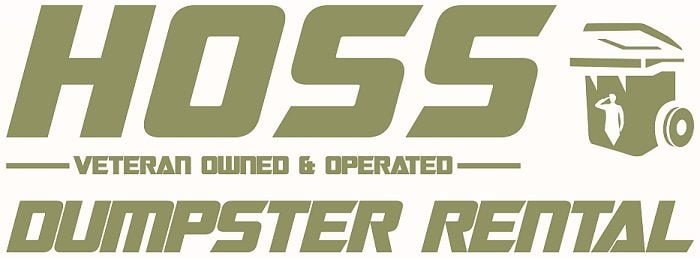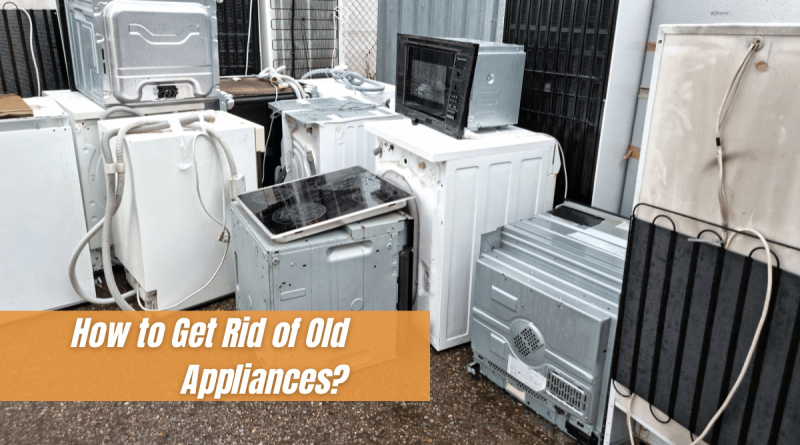How to Get Rid of Old Appliances?
How to Get Rid of Old Appliances?
Getting rid of old appliances can be a headache. Whether you’re replacing a refrigerator, upgrading a washer and dryer, or clearing out a garage filled with unused kitchen gear, figuring out how to get rid of old appliances responsibly is a task many homeowners struggle with.
At Hoss Dumpster Rental, we’ve seen it all—broken stoves, heavy water heaters, busted microwaves—and we know how to get rid of old appliances the right way. This guide will walk you through the most important steps for disposing of appliances safely, efficiently, and in an environmentally responsible way.
Let’s break it down, one part at a time.
Why Proper Appliance Disposal Matters
Environmental Hazards of Improper Disposal
Old appliances are not just bulky—they’re often filled with toxic chemicals and non-biodegradable materials. Items like refrigerators, air conditioners, and freezers contain refrigerants that can harm the ozone layer. Washing machines and dishwashers may hold traces of detergent and grease buildup. Disposing of them incorrectly contributes to:
-
Harmful gas leaks from refrigerants like Freon and other air-polluting substances
-
Oil contamination in local soil or water systems
-
Leaching of heavy metals such as mercury into landfills
Tossing an appliance into a landfill without proper treatment isn’t just illegal in many areas—it can actively damage the environment for years to come. This affects both the United States and Canada, where environmental protection laws require responsible appliance recycling and energy-conscious disposal.
Legal and Local Disposal Guidelines
Many municipalities regulate how large appliances must be discarded. In Pierce County and beyond, certain materials must be removed before recycling, such as:
-
Refrigerants from air conditioning units
-
Oils and lubricants found in older appliance models
-
Mercury switches and electronic parts
-
PCB capacitors, commonly present in vintage working appliances
Legal compliance ensures your appliance doesn’t create long-term harm or attract fines. It also guarantees the right disposal services are used for potentially dangerous items.
Benefits of Eco-Friendly Junk Removal
Choosing the right disposal method isn’t just about checking a box—it offers tangible benefits:
-
Keeps hazardous materials out of ecosystems
-
Encourages appliance recycling through proper channels
-
Reduces landfill load and promotes cleaner air
-
Often allows for donation or recovery of items in working condition
Being eco-conscious doesn’t require extra effort when you use a dumpster service that already builds sustainability into the process.
Challenges of Removing Old Appliances
Disposing of appliances isn’t as simple as hauling a bag of trash to the curb. These machines are large, heavy, and sometimes dangerous to move without the right tools or experience.
Weight and Bulkiness
Some appliances weigh hundreds of pounds and require multiple people or equipment like dollies, straps, and protective mats to move safely. Add tight doorways, staircases, or narrow hallways into the mix, and you’ve got a logistical puzzle on your hands. Even compact items like air purifiers or countertop ovens take up space and may require specific handling.
Risk of Injury or Property Damage
Attempting to drag a stove or lift a water heater alone can lead to:
-
Back, knee, or shoulder injuries
-
Scratched floors and walls inside your home
-
Broken appliances worsening already poor condition
Even small appliances can cause injury if dropped or mishandled without the right gear or support from a professional junk removal team.
Lack of Proper Transport or Equipment
Once you’ve wrestled the appliance out of your home, then what? Many people don’t own a truck or have access to a service that accepts these items. Landfills or recycling centers may reject air conditioner units or dishwashers if they contain banned refrigerants or are not properly drained.
This leaves homeowners stuck with large, non-working appliances they can’t dispose of legally or safely. Knowing how to get rid of old appliances helps avoid that scenario.
Types of Appliances You Can Get Rid of With Us
At Hoss Dumpster Rental, we make it easy to get rid of a wide range of household appliances and items. Here’s a complete list of what we accept:
-
Refrigerators and freezers (with or without working air systems)
-
Washing machines and dryers
-
Dishwashers, both built-in and portable
-
Ovens, stoves, and microwaves
-
Water heaters and heating appliances
-
Air conditioners and fans
-
Space heaters, toasters, and blenders
-
Other small kitchen appliances in any condition
If it plugs in or cools, heats, or cleans, and it’s taking up space, we’ll help you remove it and recycle what we can. It’s just another way we make how to get rid of old appliances simple.
Safe, Responsible, and Hassle-Free Appliance Removal by Hoss Dumpster Rental
At Hoss Dumpster Rental, we’ve taken the guesswork out of junk appliance removal. Here’s how we keep things stress-free and professional from start to finish:
-
Full-service removal of broken or unwanted appliances
-
On-time scheduling for your dumpster drop-off and pickup
-
No dragging heavy items through your home or scratching walls
We make it simple: you fill the dumpster, we handle the pickup and appliance disposal.
What Happens to Your Old Appliances After Pickup
When your appliances are tossed into our dumpsters, they’re not heading straight to the dump. Here’s what happens next:
Metal and Material Recovery
Many appliance parts—including copper coils, aluminum panels, and steel frames—are valuable. Once removed, these materials are processed and recycled into new appliances or energy-efficient products.
Environmentally-Safe Recycling Process
Before recycling, certain hazardous parts are removed:
-
Refrigerants from cooling units and air systems
-
Oils from motors and compressors
-
Mercury from switches or older thermostats
Responsible Disposal of Hazardous Parts
We comply with all disposal regulations, ensuring all dangerous components are taken to licensed facilities. Appliances in poor condition are handled with care to avoid chemical leaks.
Donation When Possible
If the appliance is still in working order, we explore donation options. Many appliances, even when used, are still valuable to families or facilities that can use them. That’s a responsible way to handle how to get rid of old appliances that still function.
DIY Appliance Removal vs. Professional Junk Hauling
While DIY has its place, removing appliances and junk isn’t always the best use of your weekend. Let’s compare:
| Consideration | DIY | Hoss Dumpster Rental |
|---|---|---|
| Physical Labor | High | Low |
| Cost | Variable (truck rental, fuel, fees) | Flat-rate dumpster |
| Tools Needed | Yes | None |
| Time Investment | Multiple hours | 10 minutes to book |
| Risk | High injury and home damage | None |
For small items in good condition, DIY might be fine. But if you’re unsure how to get rid of old appliances safely or legally, let professionals handle it.
Can I Leave My Appliance on the Curb?
It might seem convenient, but leaving an appliance on the curb can result in more problems:
-
Fines or rejection from sanitation services
-
Safety hazards for children or pets
-
Unwanted scavengers taking parts and leaving behind mess
Most city services don’t accept appliances without prior arrangement. Some services in the United States and Canada offer special pickup days, but they often exclude non-working or freon-filled appliances.
Knowing how to get rid of old appliances through proper channels avoids these curbside complications.
Planning an Upgrade? Here’s How to Handle the Old Appliance
If you’re planning to replace your old stove or washing machine, coordinate the disposal of the old unit to avoid delays or clutter.
-
Schedule your dumpster drop-off before the new unit arrives
-
Dispose of the older appliance and related items in one go
-
Free up space and simplify the transition
This also ensures that any other junk—like packaging from the new appliance—can be loaded into the same dumpster for full-service removal.
The Eco-Impact: Why Recycling Old Appliances Matters
Properly managing old appliances reduces waste, conserves resources, and limits environmental damage. Here’s how:
-
Extracting refrigerants and oils prevents air and soil pollution
-
Recycled metals reduce the need for new mining and energy use
-
Reusing parts or entire appliances helps others and reduces manufacturing emissions
Some older appliances even contain parts that can be refurbished and resold, keeping them in circulation and reducing junk pileups in local landfills. This is the eco-conscious side of how to get rid of old appliances the right way.
How to Book an Appliance Removal with Hoss Dumpster Rental
At Hoss Dumpster Rental, we make it easy to get rid of your old appliances without lifting a finger—except to pick up your phone or submit a contact form.
Here’s How It Works:
-
Book a Dumpster Rental
Choose your size—14 or 20 yard—based on your home project or appliance count. -
We Drop Off the Dumpster
On your chosen date, our team delivers the container. You fill it at your own pace. -
We Pick It Up and Dispose of the Contents
We haul away everything, including appliances, furniture, or renovation items.
If you’re wondering how to get rid of old appliances during your next remodel or cleanup—this is the easiest answer.
Contact Hoss Dumpster Rental Today
Veteran-owned and proudly serving Pierce County, WA, Hoss Dumpster Rental offers fast, affordable appliance removal services. Whether you’re clearing out old junk or just trying to reclaim space in your home, we’ve got you covered.
Dumpster Rental Options:
-
14 Yard Roll-Off Dumpster – $350 for 5 days
-
20 Yard Roll-Off Dumpster – $450 for 5 days
Perfect for appliance recycling, junk disposal, and cleanouts of all kinds.
Call Us: (253) 553-2978
We’ll deliver the dumpster, you load it up, and we’ll take it from there. If you’re still asking yourself how to get rid of old appliances—we’ve got your answer.

